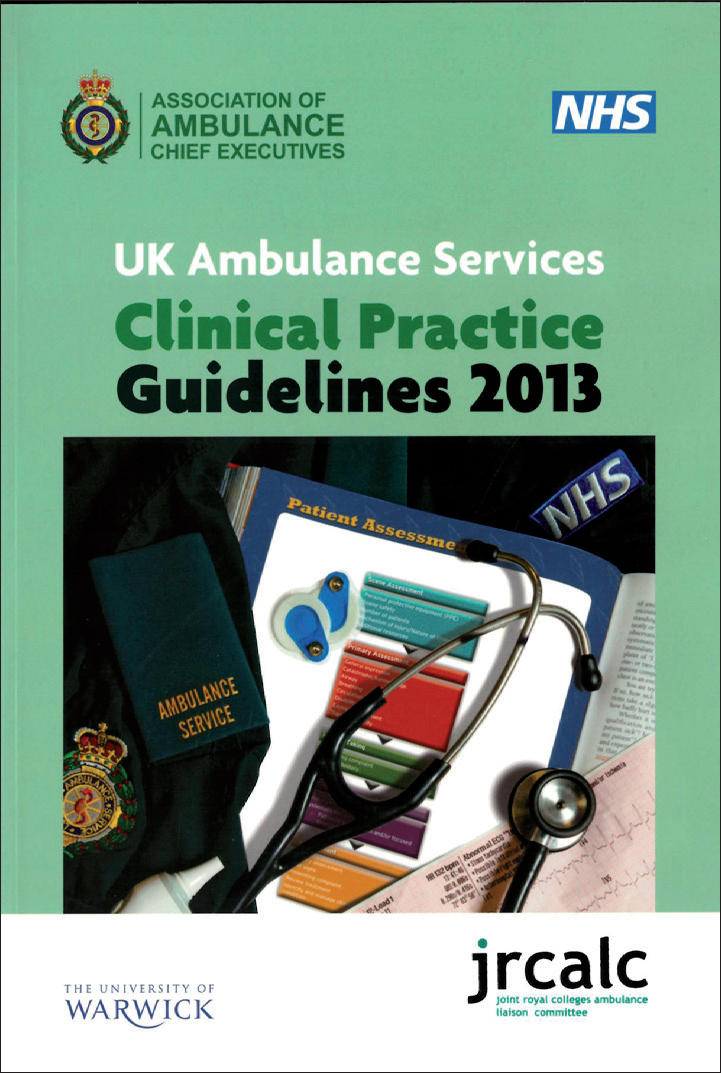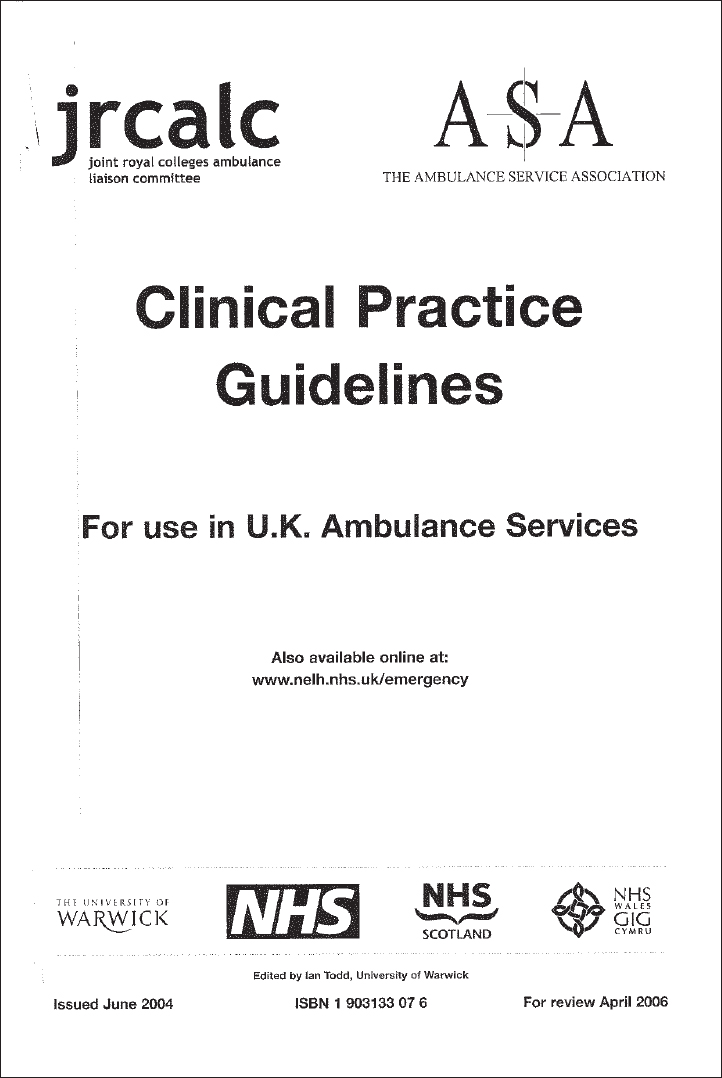
The Association of Ambulance Chief Executives (AACE) were delighted to publish the UK Ambulance Services Clinical Practice Guidelines a year ago. Many readers will of course be familiar with their appearance and content but perhaps less acquainted with their history and development. AACE are keen to ensure that they continue to be revised and improved in a timely manner and that they stay relevant to ambulance clinicians.
The process for revising and updating the guidelines is currently the subject of some discussion. AACE is looking to its National Ambulance Service Medical Directors (NASMeD) for advice on how ambulance services wish to communicate clinical guidelines in the future. Equally important is the question of how will staff wish to access guidelines and clinical updates in the years to come? Self-directed learning, pre-loaded ‘apps’, online reference material, printed pamphlets or complete reference books? Multiple opportunities arise and many different preferences exist.
The 2013 guidelines are already into their second iteration as the first print run of 60 000 copies soon sold out. The fact that we were reprinting this large book of guidelines so soon after the launch presented some ‘editorial’ difficulty. Should we change anything or keep the content the same? As with any project this size there were some small changes we needed to make by the way of typographical errors or improved grammar. A decision was also made to incorporate information on tourniquets that was published too late for earlier inclusion but not to make revisions throughout the book. Believe it or not we do not want clinicians feeling they need to buy a new copy every six months!
Ensuring guideline updates and changes to practice go into circulation in a timely manner presents many challenges and AACE does not profess to have all the answers. What is your view? We would be pleased to hear any suggestions you may have via: http://aaceguidelines.co.uk/feedback
Development
The Joint Royal Colleges Ambulance Liaison Committee (JRCALC) published the first guidance for ambulance staff in 2000 and then again in 2004 and 2006. To help their Guidelines Development Group (GDG), led by Dr Simon Brown, a team at University of Warwick was engaged to help in the challenging task of ensuring that best evidence was being used and ‘consensus’ was achieved amongst experts—no easy task. The Ambulance Service Association (ASA) commissioned this work from JRCALC on behalf of the UK's ambulance services. Now that the ASA no longer exists (it ceased to represent ambulance services soon after the main mergers in 2006), AACE has the task, on behalf of its members, of seeing that a suitable set of guidelines is developed and kept current.
Part of the reason for the long delay in updating the 2006 edition lay with the complexity of the task being undertaken by a range of people and often on a voluntary basis. A huge debt of thanks is due from all in the ambulance service to those experts that have so generously given their time.
Going forward, NASMeD will lead for AACE on the development of new guidelines. It is important that our guidelines stay the ‘gold standard’ for use in pre-hospital care. AACE are the owners of the intellectual property rights (IPR) and are mindful to maintain their currency. All NHS ambulance Trusts invested in their development and we need to ensure this investment is well managed.
It is anticipated that the Ambulance Lead Paramedics Group (ALPG) will play a key role in researching and drafting new guideline texts, and this means that your clinical guidelines will be developed by your colleagues for use in your service. JRCALC will continue to be the key reference point for the expert opinion required of guidelines that are internationally recognised as best practice. It is important that the ambulance sector ensures guidelines are developed to the highest standards and we are aware of the advice given by Harbour and Miller (2001), for example, and that from renown bodies such as the National Istitute for Health and Care Excellence (NICE).

Updates
The first update to an existing 2013 guideline was issued in December 2013. This revised Section 5 Obstetrics and Gynaecology guideline relates to delivery complications with a shoulder dystocia presentation. Following written advice from a coroner in the form of a rule 43 ruling and consultation with the expert witnesses involved, this section has been revised to give advice on additional strategies for the clinician when dealing with this potentially life-threatening complication.
As healthcare practice is constantly advancing, there is a need for the guidelines to reflect current best practice. There will be occasions where small updates are required as outlined above but there is a requirement for a strategic approach to updating the guidelines to ensure that they remain consistent with the best new evidence as it becomes available. As part of this process the spinal injuries section is currently being updated to reflect the latest consensus statement from the Faculty of Pre-hospital Care and to adopt the Canadian C-spine rules. This update will be led by the Ambulance Lead Paramedics Group who will liaise with the subject experts within JRCALC before submitting it to NASMeD to be signed off as best practice.
The next subject area that has been identified for update is mental health. Currently, there is a huge amount of work being undertaken nationally by all UK ambulance services in conjunction with police services and mental health professionals in relation to section 136 patients that involves both conveyance and appropriate receiving units. Additionally, there are a number of initiatives around the assessment of the acute mental health patient and the new guideline will capture both of these areas.
Whilst the 2013 guidelines do discuss sepsis, there is no dedicated guideline for this common condition and this is another subject area that has been identified for development. There are a number of identification tools that are used in the hospital setting and it is planned to develop a screening tool that is suitable for pre-hospital clinicians that will form the basis of a new sepsis guideline.
To continue to take the guidelines forward, the ALPG will work closely with both JRCALC and NASMeD to develop a system that delivers the most up to date guidance possible. With the current advances in the use of electronic databases and apps for both phones and tablet computers, AACE is keen to explore these alternatives to develop a user friendly interface that allows the latest version of the guidelines to be accessed quickly and easily. That said, AACE are aware that there cannot be an over reliance on new technologies, and it is anticipated that these updates will be disseminated in a variety of ways in order to be as inclusive as possible. Again, your views on how this can or should be achieved will be welcome.
Conclusions
There has been an enormous amount of hard work by numerous groups and individuals to produce the 2013 version of the JRCALC/AACE clinical guidelines. That work is now being continued to develop a system that delivers the most clinically accurate guidelines possible in a format that can be efficiently updated and accessed. The result will be clinical guidelines produced by paramedics for paramedics that will enable the best possible care to be given to our patients.

